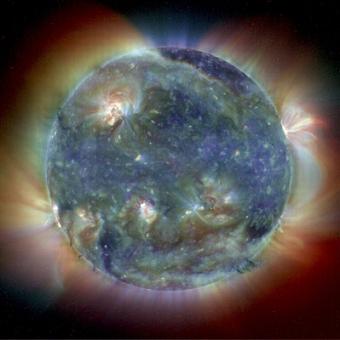Boffins crack portable particle-squall brolly tech
Posted in Space, 4th November 2008 00:02 GMT
A team of top boffins believe that they have cracked one of the main problems of interplanetary travel - that of surviving deadly solar radiation storms. The physicists say they have come up with an idea for a crafty forcefield which could stand off the protoplasm-punishing particle squalls of deep space.

There's plenty of weather on the sun.
Thus far, only a very few people have ever travelled beyond the protection of the Earth's magnetosphere - the Apollo astronauts who went to the Moon in the 1960s and 70s. All other humans in space - including the crews of the present-day International Space Station - have remained within the protective magnetic field of their home planet.
The Apollo missions were reasonably safe because they were brief - only days long. The risk of a major solar radiation storm was minimal. Even so, had there been a serious solar event during an Apollo mission the results might have been disastrous - the more so as there is no lunar atmosphere to protect explorers.
A journey to Mars, however, is projected to take 6 months - and then there's the return trip to consider. Even though the astronauts would be protected by the Martian atmosphere (and the planet itself) during their stay, a year in deep space would be very dangerous. Even normal background radiation could be expected to use up much of an astronaut's lifetime exposure limit.
A solar storm, more or less bound to occur over such a period, would breach the health guidelines and create an unacceptable risk of cancer. A bad particle squall could cause radiation sickness severe enough to incapacitate or even kill a Mars-ship crew on the spot.
But now boffins at the Rutherford Appleton Lab and the Universities of York, Strathclyde and Lisbon have shown that it's possible to generate a "portable magnetosphere" or magnetic forcefield just a few hundred metres across, which would prevent ionised particles reaching a space ship. It had previously been thought that only mighty planetary-scale fields could possibly be effective, but new computer simulations suggest that just a small "hole" in the solar winds could be enough.
“These initial experiments have shown promise," said Dr Ruth Bamford of the Rutherford Appleton lab, rather cautiously.
"It may be possible to shield astronauts from deadly space weather.”
Astronauts in a ship moving through space would find a nifty lightweight forcefield especially useful. Ordinary radiation shielding is extremely heavy, but everything in a spaceship must be as light as possible, every kilo of mass being precious. On the other hand the power required to generate a "magnetic bubble" could be an issue.
The new research would seem to have implications for NASA's plans to build a permanent Moon base, too. While lunar explorers would gain a good deal of protection from the Moon itself, blocking out half the sky, the lack of any atmosphere would see an explorer caught outside his thick-walled underground moon bunker by a solar storm during daylight in serious trouble. Moon rovers and inflatable habitats of the future might find magno-forcefield kit very handy.
Needless to say, reasonably portable forcefields would also be invaluable for the hover tanks, power-armour suits or interplanetary battlecruisers of tomorrow - ideal for resisting deadly particle-cannon blaster beams, krenon rays* etc.
The research is set out in a new paper: The Interactions of a flowing plasma with a dipole magnetic field: measurements and modelling of a diamagnetic cavity relevant to spacecraft protection (R Bamford et al 2008 Plasma Phys. Control. Fusion 50 124025). It's published online here. ®



No comments:
Post a Comment